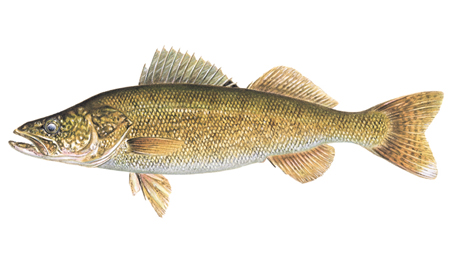Walleye have an elongated body shape. They have large teeth, and are characterized by their “glassy” opaque eyes. The sides of walleye are olive green to gold, with black patterns. The bottom tip of the tail is white.
Common Names: walleye, yellow pickerel, pickerel, wall-eyed pike
Habitat
Walleye are found throughout Ontario. They prefer turbid water, as their eyes are very light sensitive. However, they also live in clear waters, where there is sufficient cover such as extensive weedbeds, or deep water, to protect them from the light. They are also found in rivers and are frequently associated with areas of flowing water.
Spawning Patterns
Typically, female walleye mature for the first time between the ages of 4 to 6. Walleye spawn in early spring, shortly after ice out, when water temperatures are between 6–8 ºC. Walleye generally spawn on coarse, rocky shoals or in high current areas of rivers. Large female walleye produce a large number of eggs. One large female of 31” (80 cm) can produce 600,000 eggs.
Diet
Young walleye feed primarily on plankton and aquatic insects, but soon switch to a diet that is almost exclusively fish. When available, yellow perch are a particularly important food item. Due to the fact that they are very light sensitive, walleye feed most aggressively at dawn or dusk.
Age and Size
Walleye can live to be quite old, up to 25 years or more! As with many species, their growth rates vary with their environment and fish community. For example, in the Bay of Quinte, a 4-year-old walleye may be 18” (46.5 cm) and 2.75 lbs., whereas in the Kawarthas, an 18” walleye may be 6 or 7 years old.
Fishing Tips
Walleye are one of Ontario’s most sought after fish, both by anglers and commercial fishermen. They are extremely tasty, and are good fighters. As previously mentioned, they are most aggressive in low light conditions. Popular baits include worms, minnows and leeches. Many people troll or cast with plugs or crankbaits along weedlines for walleye. Jigging in the weeds can be a very effective way of catching walleye during the day. Rocky points and shoals can attract walleye throughout the summer months and they can be caught using jigs or spinners tipped with live bait, or by using deep running crankbaits. As the water temperature cools in the fall walleye will school in deep water usually off of rocky points.
Fish illustration ©CURTIS ATWATER (www.natureartists.com/atwaterc.htm)









